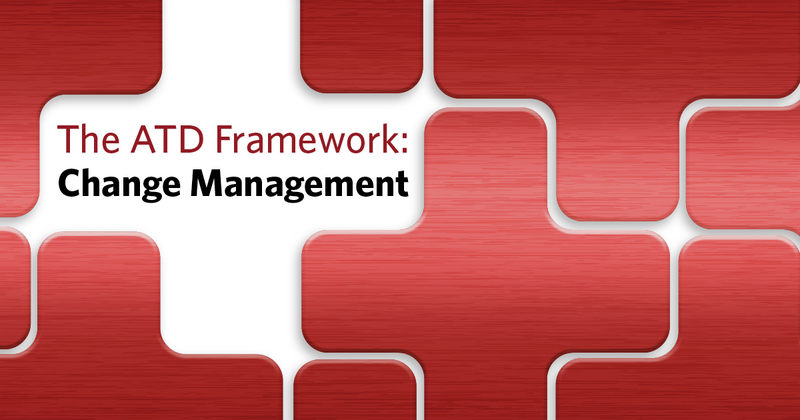ATD Blog
The ATD Talent Development Framework: Change Management
Thu Jul 21 2016

ATD developed the Talent Development Framework and the TD Puzzle to help practitioners understand the different components of talent development, and how organizations can build their own frameworks to address their unique needs. This blog series explores each component of the talent development framework, why it’s important to the field, and what resources ATD offers to practitioners who want to learn more.
Change Management
According to The ATD Competency Model, change management is the ability to apply a systematic process to shift individuals, teams, and organizations from a current state to a desired state. It entails guiding those affected by a change to engage with and commit to the change, and involves developing the ability to predict and prepare for change. The emphasis on process is critical; a Towers Watson survey found that most change initiatives fail because companies see change as a one-time event.
Companies require change-ready employees and change-able managers. When planning for change, managers should first ask, “Why change?” Holistically understanding the need for and components of change helps communication throughout the process. Employees will not follow a change plan unless they know why the change is necessary and view it as beneficial. According to learning and development manager Joshua Berkstresser, when employees know that the change will affect them and others in a positive way, they will more likely be committed and engaged, and the change initiative is more likely to be successful.
The ATD Competency Model identifies change management skills that talent development professionals need to exhibit:
• Establish sponsorship and ownership of change.
• Build involvement.
• Create a contract for change.
• Conduct diagnostic assessments.
• Provide feedback.
• Facilitate strategic planning for change.
• Support the change solution.
• Encourage integration of change into organizational culture.
• Manage consequences.
• Evaluate change results.

We live in a volatile, uncertain, complex, and ambiguous (VUCA) world, and the need for effective change management is imperative. According to organization development expert Peggy Greenberg, the ability to adjust to change makes companies exponentially more likely to succeed and grow. In other words, the more successful a company’s change management strategy, the more agile and sustainable it is against changing demands and expectations of customers.
With new challenges to face daily, change management is an essential part of a successful talent development strategy.
Here are some additional change management resources to explore:
• Assess and rate your change management skills.
• Learn about the impact of change on employees and their day-to-day work.
• Avoid unsuccessful change initiatives with these helpful insights.
• Help pinpoint the “why” to get employees on board with new changes.
• Adjust your mindset about change.
• Read more on appreciating the effects of change and rewarding them appropriately.
• 10 Steps to Successful Change Management by George Vukotich.
• TD at Work, “Change Management” by Stella Cowan.
• Change Management Training by Elaine Biech.
• The Change Book: Change the Way You Think About Change by Trish Emerson and Mary Stewart.
If improving change management is at the forefront of your educational goals, consider enrolling in ATD’s certificate program to become an effective facilitator of change.
